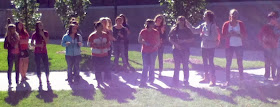I'm teaching one of our math for elementary education courses and the content includes measurement and statistics. I love measurement as a context which needs statistical understanding. Measurement introduces variability, and has a strong need for producing a number to represent typical. If the question is, "How tall is the ceiling?" then 2.60, 2.7, 2.725, 2.73, 2.735, 2.735, 2.74, or 2.76 meters is not a satisfying answer.
The oreo lesson, if you are unimaginably unfamiliar with it, is the brainchild of Christopher Danielson, aka @Trianglemancsd, the purveyor of much fine snack food mathematics. (All the oreo posts; this one is sort of a wrap up.)
Previous to this lesson, we investigated measurement, did an introduction to statistical typicals, and worked on statistical displays. (Two of those covered in a previous blogpost.) On the day before oreo day, I brought three packages of oreos to class: regular, double stuf, and mega stuf. Their interest was definitely piqued; it was like they could smell the sugar. Not much mathematical interest, though. So I prompted - what might a mathematician wonder about this? They immediately jumped to the idea of is it really double, and what is mega. Then we brainstormed together - what do we need to gather data on for the next day?
Their list:
Not bad. Calorie burning turned out not to be viable with that short of a notice... but I'd like to see it! I made a data sheet, so that we'd have a whole class worth of data, and a google spreadsheet to share.OREO: data to collectweight of the whole cookieweight of white stuf in each cookie
height of each cookie (mm)diameter of each cookie
weight of cookie/black sidesheight of black cookie
height of white stufdiameter of white stuf
how many of each size fit in a specific container/height
volume by displacement
compare deliciousness of different types
nutrition informationstuffing v serving size
calorie content (burning)
The points about measuring like a scientist (half of the smallest unit) and recording to show the accuracy measured are obviously still in progress. Also the statistical thinking of gathering and using data need more development - most were happy to answer the main question with just their measurement. "It's double." "It's more than double." "It's less than double." No one used the measurements, they went entirely by weight.
That wasn't what bothered me. I expect those kind of goals to take time.
What bothered me was that they weren't into it.
They were excited about the cookies, and figuring how many each person got, and eating the cookies afterward. But they weren't into the math.
Dave Coffey sometimes recounts (or makes fun of me for) how I want to be obsolete. Sitting back and watching students direct themselves at the end of the semester. I always want to hand off to the students. Have them make it their lesson. Look, here's a pile of data! On something interesting! What can you do with it? What else could we look into? How many ways can we come at the question?
But on this day, they said no.
My personal metaphor for this is a Smothers Brothers routine. (That's how old I am.)
(The whole brilliant bit... the show was amazing. Steve Martin got his start there as a writer, for example. They used their folk singing to make the show safe for sharp political commentary. Like we use math class as a ruse to get students problem solving and thinking critically. They were cancelled and replaced with Hee Haw.)
So this lesson felt like, "Take it, class!"
"No."
My response was to ask them to make sure they got all their group's data, and to write about the measuring and their answer to the question for a standards based grading assessment. And this is a compliant class, so they did, and did a good job on it. But that's far from the peak experience for which I was hoping with this lesson.
Part of the problem, I think, was in my desire for efficiency. By introducing the problem in the previous class and then making a record sheet, I took the initiative from them. They went into fill in the blank mode, from long habit in math class. Another part of the problem was lack of a focus, in the workshop sense. I think I should have discussed statistical thinking with them, and how that's different from single measurement thinking. It's all about the data! This is very reminiscent of the Barbie Bust. It was my problem and my lesson. "My" doesn't help me be a better teacher. (Gollum.)
Reflecting afterward, I think my high expectations helped create the sense of disappointment, like an overhyped movie. And it led me to rush into a lesson instead of building suspense and anticipation. I think this kind of experience contributes to teachers who "tried that once" and that was enough to turn them off of inquiry-based learning. In the end it is the learning that needs to be the center of engagement, not the cookie.















